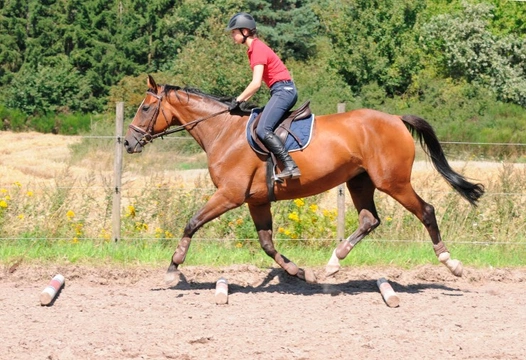
Introduction to Polework
Polework is usually thought of as an introduction to jumping and indeed it is. Poles are also used in many exercises in show jumping to help improve both jump and accuracy. But did you know that polework is also very beneficial for flatwork and as part of your general schooling regime?
Incorporating poles into flatwork
Using poles as part of your flatwork programme adds interest and diversity to what the horse is doing but there are also many other key benefits such as:-
- Polework encourages the horse’s hind leg to work a little harder which promotes suppleness
- Polework increases agility and flexibility as the horse has to lift his legs higher
- The horse has to work harder and stretch a little over his top line promoting longitudinal and lateral suppleness
- Poles can be used to influence the horse’s stride length so by setting the poles a little further apart you can encourage the horse to open his frame and stretch down and forward
- For collected work, set the poles closer together so the horse has to shorten his stride, lift his frame and elevate
- Poles are great for horse’s that tend to rush as it regulates the stride pattern
- Polework encourages precise and accurate riding and improves balance and control, it is particularly useful at promoting straightness
- Polework encourages riders to look up and ride forward and brings some of the forward focus required for jumping without the need to actually jump
There are myriad exercises that can be included in a flatwork session using poles. Poles can be used on both straight lines and circles. It is important to introduce the horse progressively to the poles so always start by walking and trotting over a single pole and then progress to three poles rather than two. Horses that tend to rush or become overexcited may read two poles as something to jump whereas three poles in a line will discourage this.
It is important to get the distances correct between the poles for your size of horse and his stride length. For this reason, it is usually better if there is someone on the ground who is experienced and who can place the poles for you. This is particularly helpful if you want to adjust the stride length of your horse by changing the distance between the poles but also if the horse knocks or chips a pole and moves it – this will save you from dismounting to correct it and remounting.
Here are a few simple but effective pole exercises which you should enjoy riding with your horse.
- Set four poles on a twenty-metre circle, each pole at the quarter marker on the circle. If you treat the circle like the face of a clock, then the poles would sit at 12, 3, 6 and 9 o clock. Ride the circle in trot aiming for the centre of each pole ensuring that you keep the same number of strides between each of the poles. The horse should remain at the same speed and in rhythm. Keep the horse straight so that the quarters are behind the shoulders and that he is bent in the direction of travel. The horse should not fall either in or out. Keep looking ahead to the next pole. To make the exercise more challenging, incorporate a ten-metre circle around some of the poles, this can either be ridden on the same rein or on the other rein before changing the rein back again and continuing the exercise
- Fan four poles out on a circle ensuring that the distance through the centre of the poles is correct for your horse. The fan can be used to change the horse’s stride length. By riding to the inside of the poles the horse will need to shorten his stride and collect, the centre of the poles should be the horse’s natural stride length and the outside line should encourage the horse to stretch forward and take a bigger but not quicker stride. This is a great way to develop the horse’s trot and can be ridden without assistance as there should be no need to adjust the poles once they are set up unless the horse moves one by accident
- Set out two poles quite far apart one at each end of the arena. Canter over the poles on a straight line in your horse’s normal canter several times counting the strides as you go. Then vary the exercise by asking the horse to add more strides between the poles, each stride should be the same but shorter. Then ask the horse to move between the two poles on a more forward canter thereby reducing the number of strides between the two poles. This is a great exercise to develop the canter and encourages the horse to listen obediently to the aids. It teaches the horse to be adjustable within the gait whilst retaining balance and rideability
For polework, try and use striped poles with a central colour so that it is easier to identify the centre of the pole. Always ride to the centre of the pole even if the pole is offset to your line unless the exercise specifically requires that you move to one side of the centre such as the fan exercise above.
Polework offers variety and interest to flatwork schooling and has huge benefits for jumping horses as well, promoting rhythm, accuracy and straightness. There are hundreds of different exercises to choose from and it can be great fun for children as part of their lessons too.



